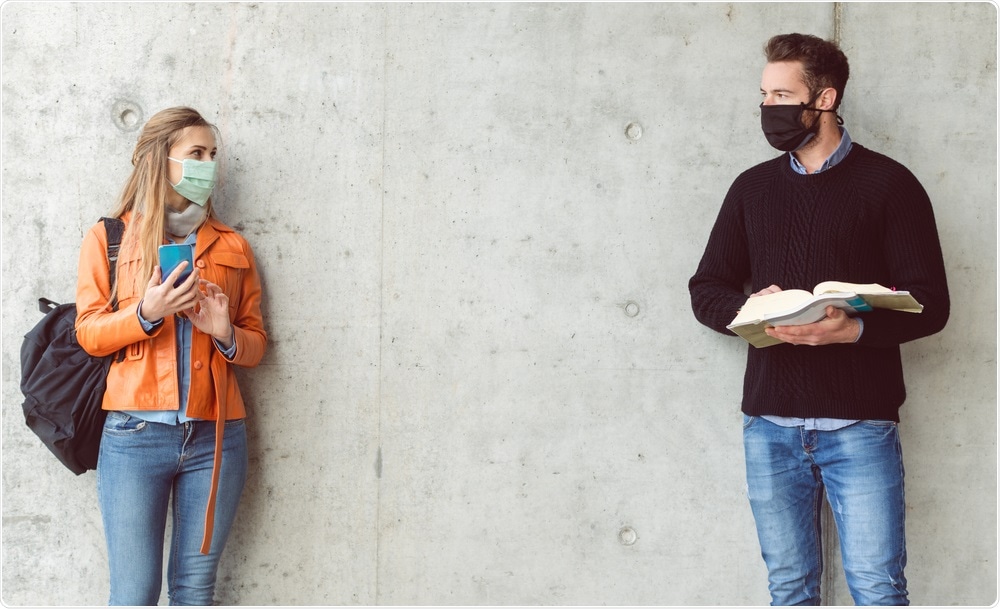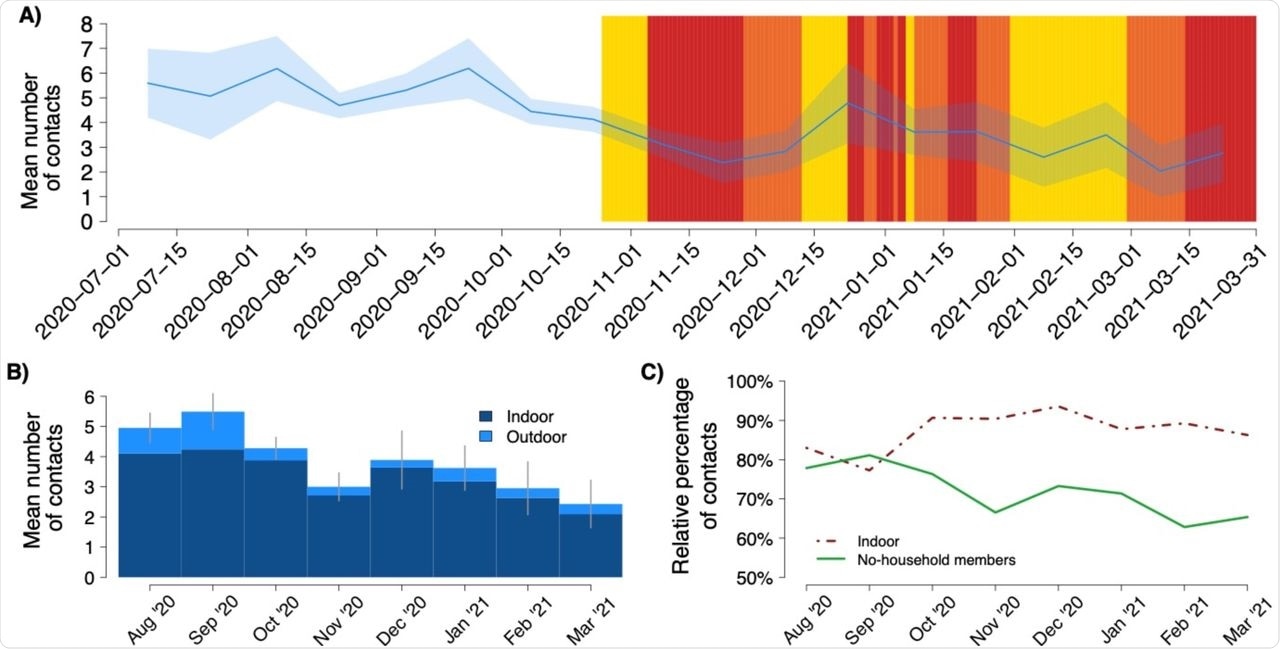A recent study investigates the impact of varying interventions, consequent contact patterns, and the transmissibility of the severe acute respiratory syndrome coronavirus 2 (SARS-CoV-2), under the evolving epidemiological situation in Italy.
 Study: Investigating the relationship between interventions, contact patterns, and SARS-CoV-2 transmissibility. Image Credit: Kzenon / Shutterstock.com
Study: Investigating the relationship between interventions, contact patterns, and SARS-CoV-2 transmissibility. Image Credit: Kzenon / Shutterstock.com

 This news article was a review of a preliminary scientific report that had not undergone peer-review at the time of publication. Since its initial publication, the scientific report has now been peer reviewed and accepted for publication in a Scientific Journal. Links to the preliminary and peer-reviewed reports are available in the Sources section at the bottom of this article. View Sources
This news article was a review of a preliminary scientific report that had not undergone peer-review at the time of publication. Since its initial publication, the scientific report has now been peer reviewed and accepted for publication in a Scientific Journal. Links to the preliminary and peer-reviewed reports are available in the Sources section at the bottom of this article. View Sources
Background
The coronavirus disease 2019 (COVID-19) pandemic, which is caused by SARS-CoV-2 infection, rapidly surged in Italy during the fall of 2020. Soon after this surge, the Italian government introduced a three-tiered restriction system as part of the non-pharmaceutical interventions to increase physical distance and reduce contacts.
To this end, the Ministry of Health assigned a tier of yellow, orange, or red to each of the 21 Italian regions and autonomous provinces (AP), in which each color of the three tiers corresponded to increasing levels of restrictions. The determination of a region’s risk level was completed after an epidemiological risk assessment based on a combination of quantitative indicators such as the estimated level of transmission and the burden on the healthcare system.
However, it is not well quantified to what extent different measures promoting physical distancing alter mixing patterns and how quickly the population adapts their social interactions to continuous changes in restrictions.
“A fundamental question that is still open is whether the change of mixing patterns associated with the implemented restrictions can be used to anticipate the effect of a given intervention on SARS-CoV-2 transmissibility.”
To address this, the authors of the current investigated the changes in the number of contacts and mixing patterns linked to the gradual tightening of non-pharmaceutical interventions adopted by the Italian government during the second wave of the COVID-19 pandemic.
About the study
In the current study, the researchers conducted a contact survey in the metropolitan city of Milan, which is in the Lombardy Region of Italy, between July 2020 and March 2021 through online interviews. Additionally, data was collected in collaboration with Centro Medico Sant'Agostino (CSM), a private healthcare center that is part of the National Health Service.
The researchers interviewed a total of 1,785 individuals. Of these, 40 study participants (2.2%) reported having tested positive for SARS-CoV-2 immunoglobulin G (IgG) antibodies prior to the interview.
In the survey, the researchers collected information on the number and type of daily contacts made by study participants over the course of the pandemic when interventions of different intensity were in place. The researchers tabulated a detailed sample description and mean number of daily contacts per person as recorded under different tiers.
From this data, the researchers assessed the impact of adopted restrictions on human mixing patterns and, through the use of mathematical modeling, estimated their effect on SARS-CoV-2 net reproduction number.
The researchers defined a contact as a physical interaction or a two-way conversation of at least five words in the physical presence of another person and for each reported contact.
Study findings
Independent of age, the researchers found that the introduction of the tiered restriction system strongly influenced the number of social interactions of the study participants.
The researchers compared their observations to the contacts observed before the introduction of the tiered restriction system and found that this corresponded to a relative reduction in the overall number of contacts of 18.9%, 34.6%, and 45.9% for mild, moderate, and strong restrictions, respectively.
The researchers reported varying observations on mixed patterns. To this end, the most marked changes were observed among the young individuals who were younger than 20 years. However, individuals between the ages of 20-29 years were least affected by the tier change. While inactive individuals showed a higher reduction in contacts compared to students and employed individuals, participants from larger households reported a higher number of daily contacts in all tiers.
Serological test results from the participants interviewed under the white tier indicated that those participants who tested negative for SARS-CoV-2 IgG antibodies prior to the interview reported a slightly higher mean number of contacts.
Probing age-specific mixing patterns under different tiers, the researchers noted that in addition to reducing the overall number of social interactions, higher restrictions levels also increased the relative contribution of contacts between young adults (aged 30-50 years) with individuals of similar age and with individuals younger than 10 years of age. This observation is likely due to the interactions occurring between household partners, as well as between parents and their children.
In late summer, the number of daily contacts per participant increased significantly. This increase can be explained due to a temporal relaxation in social distancing, aside from the personal protective equipment (PPE) mandate, in light of an improved epidemiological situation compared to spring 2020. However, the results also highlight that the Christmas holidays might have temporarily increased contacts occurring indoors with non-family members.
 A) Colored rectangles represent the tiers assigned to Lombardy over the study period. The blue line represents the average number of daily contacts over time with respective 95% CI (shaded blue area). B) Bars represents the mean number of contacts reported by the study participants in different months, stratified by contacts occurred indoor and outdoor. Grey lines represent 95% confidence intervals of the overall number of daily contacts per person across different months. C) The dashed and solid lines represent respectively the proportions of contacts occurring indoor and of contacts occurring with no-household members across different months.
A) Colored rectangles represent the tiers assigned to Lombardy over the study period. The blue line represents the average number of daily contacts over time with respective 95% CI (shaded blue area). B) Bars represents the mean number of contacts reported by the study participants in different months, stratified by contacts occurred indoor and outdoor. Grey lines represent 95% confidence intervals of the overall number of daily contacts per person across different months. C) The dashed and solid lines represent respectively the proportions of contacts occurring indoor and of contacts occurring with no-household members across different months.
Further, the researchers measured the impact of the restrictions on SARS-CoV-2 transmissibility. To this end, the SARS-CoV-2 reproduction number was estimated to decrease by 18.7%, 33.4%, and 50.2% under the yellow, orange, and red tiers, respectively. Despite an analysis of the contact patterns only, in which there was not any direct knowledge of the actual transmission patterns, these estimates on the relative reduction of transmissibility potential are consistent with previous findings.
Conclusion
The current study provided estimates of the changes in the number of contacts and mixing patterns linked to the gradual tightening of non-pharmaceutical interventions and their potential impact on SARS-CoV-2 transmission.
The researchers found an overall progressive temporal decrease in the mean number of contacts recorded by the study participants from 16.4% under mild restrictions (yellow tier), to 45.6% under strong restrictions (red tier). The SARS-CoV-2 reproduction number was also estimated to decrease with increasing restrictions.
This study confirms the strong relation between observed dynamics and the changes characterizing the tiers assigned to Lombardy over the study period. Thus, these findings can help anticipate the impact of imposed interventions.

 This news article was a review of a preliminary scientific report that had not undergone peer-review at the time of publication. Since its initial publication, the scientific report has now been peer reviewed and accepted for publication in a Scientific Journal. Links to the preliminary and peer-reviewed reports are available in the Sources section at the bottom of this article. View Sources
This news article was a review of a preliminary scientific report that had not undergone peer-review at the time of publication. Since its initial publication, the scientific report has now been peer reviewed and accepted for publication in a Scientific Journal. Links to the preliminary and peer-reviewed reports are available in the Sources section at the bottom of this article. View Sources
Journal references:
- Preliminary scientific report.
Trentini, F., Manna, A., Balbo, N., et al. (2021). Investigating the relationship between interventions, contact patterns, and SARS-CoV-2 transmissibility. medRxiv. doi:10.1101/2021.11.03.21265876. https://www.medrxiv.org/content/10.1101/2021.11.03.21265876v1.
- Peer reviewed and published scientific report.
Trentini, Filippo, Adriana Manna, Nicoletta Balbo, Valentina Marziano, Giorgio Guzzetta, Samantha O’Dell, Allisandra G. Kummer, et al. 2022. “Investigating the Relationship between Interventions, Contact Patterns, and SARS-CoV-2 Transmissibility.” Epidemics 40 (September): 100601. https://doi.org/10.1016/j.epidem.2022.100601. https://www.sciencedirect.com/science/article/pii/S1755436522000469.